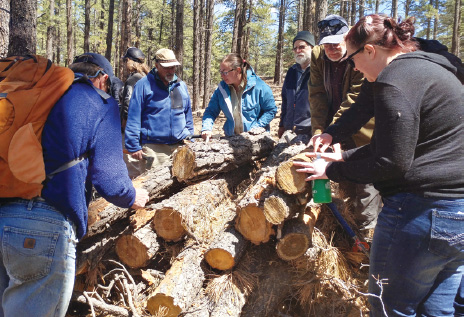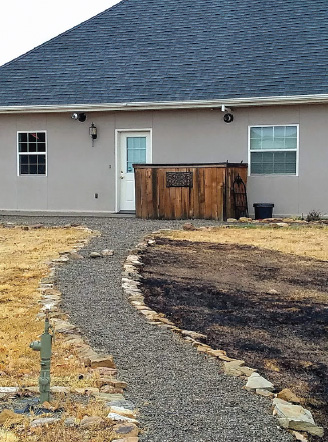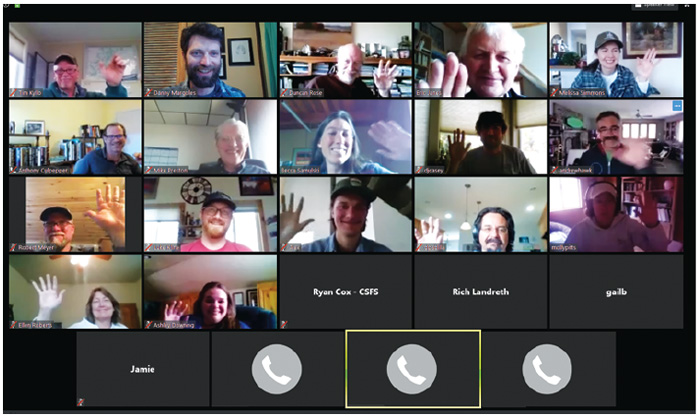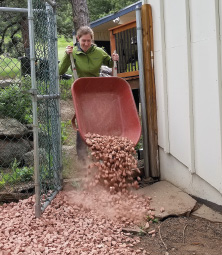
DWRF and Wildfire Adapted Partnership hosted several opportunities
to learn about beetle identification and management in the forest with
Colorado State Forest Service and USFS entomologists at Butler Corner
in spring 2018. Photo by Ashley Downing.
Another weekend at home and there is no shortage of things to do. Along with the planting, and spring cleaning, I am trying to do my part in the Dolores Watershed Resilient Forest (DWRF) Collaborative.
We all live and work in a watershed. Until mid-March, my office was at Dolores Fire Station #1 in the upper Dolores River watershed, whose river, surrounding forests, and 350,000-acre-foot McPhee reservoir catch, store, and filter the highquality water this community relies upon for drinking, agriculture, recreation, and more. (Now I’m working from my home at the top of the McElmo watershed just over the ridge from the Dolores. My Montezuma Water Company water still comes from the mighty Dolores.)
Droughts, beetle infestations, and a longer fire season each year pose threats to the beautiful forests and clean water that enrich and support our thriving community. This is why I felt heartened by the smiling faces of 30 of my fellow citizens joining the first entirely virtual meeting of the DWRF Collaborative from home offices and kitchen tables.
Since the summer of 2015, this dedicated group of land, water, wildlife, and fire managers; scientists; conservationists; timber entrepreneurs; and government and non-profit leaders have been sharing knowledge and resources toward a community and ecosystem that will be more resilient to wildfire and other disturbances.

After the Ridge Subdivision fire last November, it
was very apparent how the seemingly small steps
of weed whacking around a building and adding
some gravel can change the outcome of a fast-moving wildfire. Photo by Rebecca Samulski.
The DWRF Collaborative has made great strides in the five years since its first gathering, yet there is still a lot of important work that each of us, as community members, can do to reduce wildfire risk, leveraging our rich local knowledge and resources. Wildfire Adapted Partnership (WAP), the Natural Resources Conservation Service (NRCS), Colorado State Forest Service (CSFS), local fire protection districts, and CSU extension have experts who can provide personalized home wildfire risk assessments, private forest management planning (brush and weeds, too), and partial cost reimbursement or other incentive programs to help get the work done.
They also have lists of professionals, those who perform a wide range of vegetation management, including highly skilled sawyers who can work close to your home, equipment operators, and goat herders. Today there are more professional services than ever to meet the needs of your specific property. Many of them are able to operate on private lands, taking extra distancing, safety, and sanitation precautions to provide essential wildfire preparedness services.
Landowners throughout the area have directly benefited from this expert knowledge and connection to support programs. In 2019, 42 landowners completed defensible space cost-share projects with Wildfire Adapted Partnership and 64 used their chipper rental rebate program, including many neighborhood groups (www.wildfireadapted.org).
Roadside thinning was accomplished at a neighborhood scale through the leadership of neighborhood ambassadors, such as in Oakview north of Mancos and Wingspread subdivision overlooking McPhee Reservoir. WAP conducted over 170 walkthrough wildfire risk assessments with homeowners, they also completed over 500 rapid curbside risk assessments for all structures in the town of Dolores. DWRF partners are planning an online event in late May to share the results of the rapid risk assessments along with fire season updates and resources.
See the DWRF website for details (www.dwrfcollaborative.org).

Members of the DWRF collaborative took part in a Zoom meeting in April. Courtesy photo.
Larger properties and those with agricultural status can work with the NRCS or CSFS on forest management plans and implementation projects. The Nature Center at Butler Corner has been able to leverage work on the neighboring San Juan National Forest to get extensive private land thinning done at the interface of forested public and private lands.
Projects like these that span administrative boundaries help protect our communities, enhance personal and professional relationships, and provide an example to others.
Work at Butler Corner has enabled skill development with federal, local fire department, non-profit, and private firefighters burning slash piles in the snow together. The welcome center at Butler Corner has also hosted several educational events such as pine beetle workshops.
In order to be eligible for thinning work, landowners have to remove the fine fuels around their homes and outbuildings. For some this has included adding rock along foundations, cutting back and pulling out bushes (those ones that vex you every time you want to wash the windows anyway) and relocating firewood piles.
There is a lot to be said for the way the DWRF collaborative has been able to convene diverse stakeholders and find common ground, enabling a resurgence of the timber industry.
Aspen Wood Products is producing excelsior on the site where the Western Excelsior Mill burned down in 2017. Small-diameter and low-grade ponderosa pine is being used to create veneer panels for plywood production by the Iron Wood Group.
Montrose Forest Products has re-tooled their dimensional lumber mill, enabling projects that include high-quality ponderosa pine on the San Juan National Forest.
This industry growth has given careful consideration and support to maintain smaller operations like Stonertop, West Fork Lumber, Truelson’s, Ott’s and Gray’s logging and milling. This industry resurgence is exciting for the economy while the way it is being approached is exciting for the sustainability of our forests.
Careful attention is being paid to combining logging and non-commercial thinning of smaller diameter trees and brush with rest, grazing, and prescribed fire. Forest and watershed monitoring and adaptive management protocols are being developed with scientists and conservation leaders working alongside agency resource managers.

Laying gravel to make a 5-inch buffer between vegetation and the foundation is a best practice to make any building more fire resistant. Photo courtesy Boulder County Wildfire Partners.
Too often, the national conversation about wildfires ends up focusing only on large-scale logging, prescribed fire and thinning needs on public lands. While those efforts are critical, so too are smaller- scale efforts within and adjacent to our communities. If we really want to reduce the risk to our communities from wildfire, experts and detailed modeling both point to private forests and the areas around our homes as the most critical for avoiding wildfire disasters.
The City of Cortez water plant supervisor is updating the city’s Source Water Protection Plan to include the need for avoiding severe large-scale fires in the Dolores watershed.
Montezuma County is updating their Hazard Mitigation Plan to help capture FEMA support of local pre-disaster mitigation projects.
Cortez Fire has added a new wildfire section supporting private land prescribed burning in their district and working on fuels reduction projects on city land.
Dolores Fire requests support of a mill levy increase this fall to enable them to match grant opportunities with local revenues to replace outdated equipment as the demand for their volunteer services increases.
What will you do?

